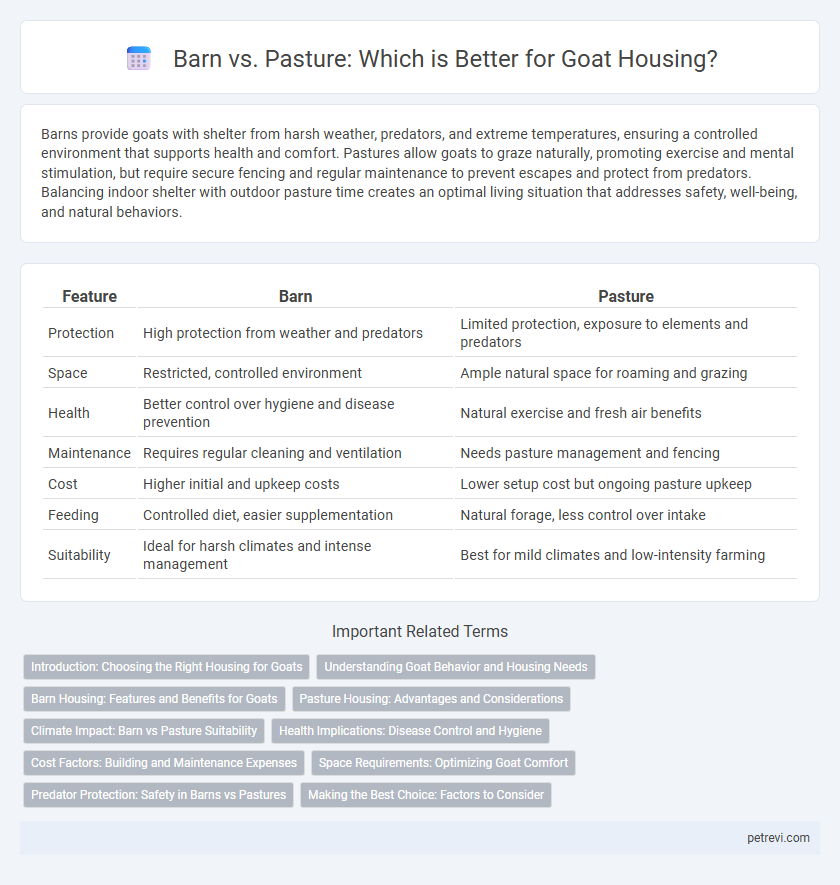Barns provide goats with shelter from harsh weather, predators, and extreme temperatures, ensuring a controlled environment that supports health and comfort. Pastures allow goats to graze naturally, promoting exercise and mental stimulation, but require secure fencing and regular maintenance to prevent escapes and protect from predators. Balancing indoor shelter with outdoor pasture time creates an optimal living situation that addresses safety, well-being, and natural behaviors.
Table of Comparison
| Feature | Barn | Pasture |
|---|---|---|
| Protection | High protection from weather and predators | Limited protection, exposure to elements and predators |
| Space | Restricted, controlled environment | Ample natural space for roaming and grazing |
| Health | Better control over hygiene and disease prevention | Natural exercise and fresh air benefits |
| Maintenance | Requires regular cleaning and ventilation | Needs pasture management and fencing |
| Cost | Higher initial and upkeep costs | Lower setup cost but ongoing pasture upkeep |
| Feeding | Controlled diet, easier supplementation | Natural forage, less control over intake |
| Suitability | Ideal for harsh climates and intense management | Best for mild climates and low-intensity farming |
Introduction: Choosing the Right Housing for Goats
Goat housing options include barns and pastures, each offering distinct benefits for health and productivity. Barns provide controlled shelter from extreme weather, enhance protection from predators, and facilitate easier management of feeding and healthcare. Pastures allow goats to graze naturally, promote exercise, and support their behavioral needs, contributing to overall well-being and milk quality.
Understanding Goat Behavior and Housing Needs
Goats display natural behaviors such as climbing, exploring, and seeking shelter that influence their housing preferences between barns and pastures. Proper goat housing must provide protection from extreme weather while allowing space for movement and social interaction, which barns often accommodate but pastures supply access to fresh forage and exercise. Integrating secure fencing and varied terrain in pasture settings supports goats' instinctual behaviors, whereas well-ventilated barns protect them from predators and harsh conditions, balancing their behavioral needs and health requirements.
Barn Housing: Features and Benefits for Goats
Barn housing for goats provides protection from extreme weather, predators, and parasites, ensuring a controlled environment that supports health and productivity. Features such as proper ventilation, insulated walls, and durable flooring promote comfort and hygiene, reducing respiratory issues and hoof problems. This type of shelter enables efficient management of feeding, breeding, and milking, optimizing overall goat welfare and farm profitability.
Pasture Housing: Advantages and Considerations
Pasture housing for goats promotes natural foraging behavior, enhances animal welfare, and reduces feed costs by allowing access to fresh grasses and shrubs. It supports better hoof health through natural terrain exposure and minimizes respiratory issues linked to confined spaces. Effective pasture management requires rotational grazing to prevent overgrazing, parasite control, and providing shelter for protection against extreme weather.
Climate Impact: Barn vs Pasture Suitability
Barn housing for goats offers controlled environmental conditions, reducing exposure to extreme weather and minimizing stress-related health issues, which can lower greenhouse gas emissions from veterinary care and feed waste. Pasture systems support natural grazing behaviors and promote soil carbon sequestration through managed grazing, enhancing carbon sinks and biodiversity. Climate impact suitability depends on regional weather patterns, with barns favored in harsh climates for protection and pastures preferred in temperate zones for sustainability benefits.
Health Implications: Disease Control and Hygiene
Barn housing for goats enables controlled environments that reduce exposure to parasites and pathogens by providing dry, clean bedding and minimizing contact with contaminated soil. Pasture housing promotes natural behaviors and airflow but increases risks of parasitic infections like coccidiosis and internal worms due to grazing on potentially contaminated grass. Effective disease control requires regular cleaning in barns and rotational grazing systems in pastures to maintain goat hygiene and prevent outbreaks of infectious diseases.
Cost Factors: Building and Maintenance Expenses
Barns require a higher initial investment due to construction materials, labor, and insulation needs, while pastures have minimal setup costs limited to fencing and basic shelter. Maintenance expenses for barns include regular repairs, cleaning, and ventilation system upkeep, whereas pastures demand consistent pasture management, fencing repairs, and occasional shelter upgrades. Cost-efficiency depends on herd size, climate, and available land, with pastures often preferred for low-budget operations and barns favored for high-density or extreme weather conditions.
Space Requirements: Optimizing Goat Comfort
Goat comfort relies heavily on adequate space, with barns requiring at least 15-20 square feet per goat for resting and shelter, while pastures demand a minimum of 250 square feet per goat to allow for grazing and natural movement. Proper airflow and drainage in barns prevent moisture buildup, reducing the risk of respiratory issues, whereas pasture space supports exercise and natural behaviors essential for mental well-being. Optimizing these spatial requirements enhances goat health, productivity, and overall welfare.
Predator Protection: Safety in Barns vs Pastures
Barns provide superior predator protection for goats through solid walls, secure doors, and elevated structures that prevent unauthorized access. Pastures expose goats to higher risks from predators like coyotes and wolves due to limited shelter and visibility obstructions. Implementing reinforced fencing and motion-activated lights can mitigate some dangers but typically do not match the safety offered by barns.
Making the Best Choice: Factors to Consider
Choosing between barn and pasture housing for goats depends on factors such as climate, predator protection, and available resources. Barns offer shelter from harsh weather and controlled feeding environments, while pastures provide natural grazing opportunities and exercise. Prioritizing goat health, safety, and nutrition ensures optimal housing decisions tailored to specific farm conditions.
Barn vs Pasture for Goat housing Infographic

 petrevi.com
petrevi.com